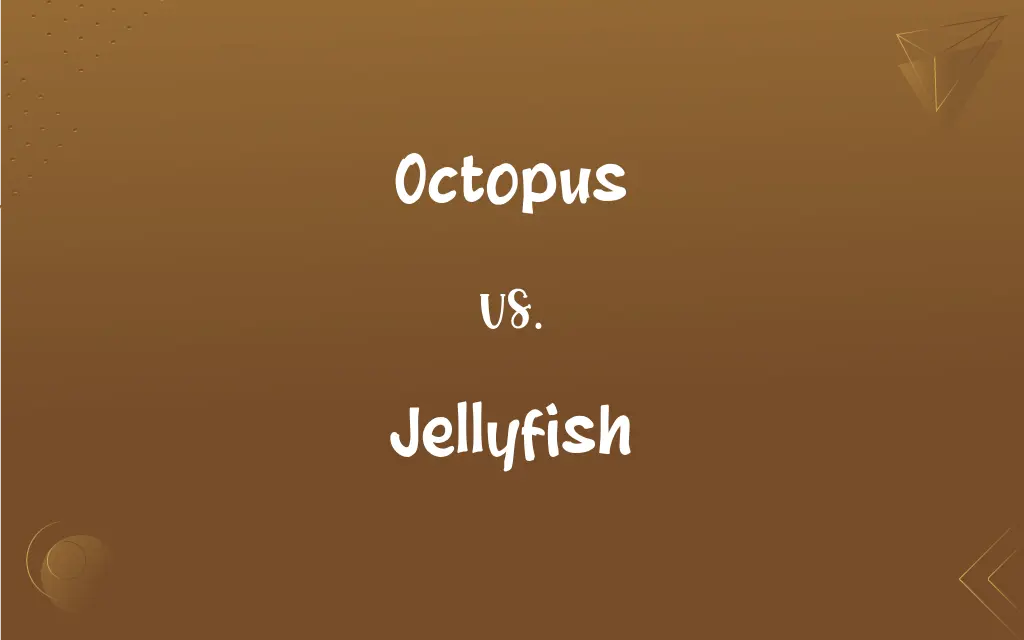Octopus vs. Jellyfish: What's the Difference?
Edited by Janet White || By Harlon Moss || Updated on October 12, 2023
An octopus is a soft-bodied, eight-armed mollusk with no skeleton, while a jellyfish is a free-swimming marine coelenterate with a jellylike bell and trailing tentacles.

Key Differences
The octopus belongs to the mollusk class, characterized by a soft, bilaterally symmetrical body and, notably, eight arms. On the other hand, the jellyfish, part of the phylum Cnidaria, displays a bell-shaped, gelatinous body and might possess numerous tentacles. Both creatures represent a fascinating array of adaptations to their marine environments, yet their physiological structures are distinctly different.
While the octopus is renowned for its intelligence and problem-solving abilities, the jellyfish possesses only a basic nerve net and lacks a brain. The octopus can exhibit complex behaviors, such as using tools, escaping predators, and navigating through mazes. Conversely, jellyfish exhibit relatively simple behaviors, largely propelled by currents, yet some species exhibit directional movement, navigating up and down in the water column.
The octopus employs a powerful beak, hidden within its soft body, to handle prey, demonstrating impressive hunting strategies. Contrarily, jellyfish utilize their tentacles, adorned with specialized cells known as cnidocytes that release venom to stun or kill prey. The feeding mechanisms and predatory tactics between the octopus and jellyfish, thus, significantly differ, showcasing a rich diversity in survival strategies.
An octopus possesses a well-developed nervous system and eyes, providing it with keen sight to navigate its environment and locate prey. In stark contrast, a jellyfish’s sensory organs are much more primitive, with some species possessing eye spots that detect only light and dark. This delineation between the sensory capabilities of an octopus and a jellyfish elucidates the disparities in their interactions with the surrounding environment.
Despite residing within similar marine environments, the octopus and jellyfish embody diverse survival strategies and physiological structures. The octopus demonstrates a higher level of cognitive functioning and physical adaptability, while the jellyfish reveals a simplistic yet effective mode of existence. Both organisms, with their unique capabilities and characteristics, emphasize the multifaceted, adaptive nature of life in the world's oceans.
ADVERTISEMENT
Comparison Chart
Taxonomic Class
Mollusca
Cnidaria
Body Structure
Soft body, bilaterally symmetrical, eight arms
Bell-shaped, gelatinous body, tentacles
Nervous System
Well-developed nervous system and eyes
Basic nerve net, rudimentary sensory organs
Feeding Mechanism
Uses a beak and arms, active predator
Uses tentacles with cnidocytes, passive feeder
Mobility
Uses jet propulsion and can crawl
Mostly drifts with the current, minimal control
ADVERTISEMENT
Octopus and Jellyfish Definitions
Octopus
Octopuses exhibit a range of behaviors demonstrating notable intelligence and problem-solving abilities.
To access a tasty crab, the octopus ingeniously manipulated the jar’s lid, unscrewing it with ease.
Jellyfish
A jellyfish is a free-swimming marine animal with a gelatinous, bell-shaped body and tentacles.
The jellyfish floated gracefully through the ocean, its tentacles trailing delicately behind.
Octopus
An octopus is a cephalopod mollusk with a soft body, eight limbs, and advanced cognitive capabilities.
The octopus navigated through the coral reefs, skillfully using its arms to explore and find food.
Jellyfish
Jellyfish employ tentacles adorned with cnidocytes, specialized cells that release venom to capture prey.
The small fish was paralyzed the moment it brushed against the jellyfish’s venomous tentacles.
Octopus
Octopuses possess a radula and a beak, which they employ to consume and manipulate prey.
The octopus utilized its sharp beak to penetrate the shell of the crustacean, accessing the succulent meat within.
Jellyfish
Jellyfish, often translucent, can exhibit bioluminescence, producing their own light in dark ocean depths.
Illuminating the dark waters, the jellyfish created a mesmerizing light show through its bioluminescence.
Octopus
The octopus, predominantly marine, typically has a saccular body and lacks an external shell.
Divers admired the octopus as it gracefully expanded and contracted its soft, saccular body amidst the rocks.
Jellyfish
Lacking a brain, heart, and bones, jellyfish possess a simple nerve net for basic motor functions and responsiveness.
Despite its simplicity, the jellyfish responds to stimuli, contracting its bell to propel itself forward.
Octopus
Notably, the octopus can rapidly alter its skin color and texture for camouflage and communication.
Startlingly, the octopus vanished into the background, its colors melding perfectly with the seaweed.
Jellyfish
Jellyfish participate in a complex life cycle, transitioning through various stages from polyp to medusa.
In the medusa stage, the jellyfish takes on its iconic bell shape, freely drifting through the ocean currents.
Octopus
Any of various carnivorous marine cephalopod mollusks chiefly of the family Octopodidae, having a soft body, eight arms with suckers, a large distinct head, and a mouth with a strong beak.
Jellyfish
Any of numerous usually free-swimming marine cnidarians of the class Scyphozoa, characteristically having a gelatinous, tentacled, often bell-shaped medusa stage as the dominant phase of its life cycle. Also called true jellyfish.
Octopus
Something, such as a multinational corporation, that has many powerful, centrally controlled branches.
Jellyfish
Any of various similar or related cnidarians.
FAQs
Can octopuses change color?
Yes, octopuses can change color and texture due to specialized cells in their skin called chromatophores.
What do octopuses eat?
Octopuses typically eat crabs, shrimp, and various shellfish, which they often crack with their beaks.
What is the primary habitat of an octopus?
Octopuses primarily inhabit various marine environments, including coral reefs, pelagic waters, and the ocean floor.
How many arms does an octopus have?
An octopus has eight arms.
Are jellyfish venomous?
Yes, many jellyfish species have tentacles with venomous cnidocytes to stun or kill prey.
Are octopuses solitary animals?
Yes, octopuses are typically solitary and meet only to mate.
How big can jellyfish get?
Jellyfish sizes vary significantly; the largest, the lion’s mane jellyfish, can have tentacles stretching over 120 feet.
Can octopuses regrow lost arms?
Yes, octopuses can regrow lost arms, a process known as regeneration.
How intelligent are octopuses?
Octopuses are considered highly intelligent, demonstrating problem-solving and learning capabilities.
Can jellyfish glow in the dark?
Some jellyfish species can produce bioluminescence, allowing them to glow in the dark.
How many species of octopus are there?
There are approximately 300 recognized species of octopus.
What do jellyfish eat?
Jellyfish primarily consume small fish, plankton, and other small sea creatures.
Do jellyfish have brains?
Jellyfish do not have brains; they have a basic nerve net for simple motor functions.
Can jellyfish be found in every ocean?
Yes, jellyfish can be found in every ocean and in various conditions, from shallow coastal waters to deep-sea environments.
Do jellyfish sting humans?
Some jellyfish can sting humans, which can range from a mild irritation to severe, life-threatening reactions, depending on the species.
How do octopuses reproduce?
Octopuses reproduce by the male inserting a specialized arm into the female’s mantle cavity to transfer spermatophores.
How do jellyfish move?
Jellyfish primarily move by contracting and relaxing their bell-shaped body, propelling themselves through the water.
Are all jellyfish translucent?
While many jellyfish species are translucent, some can be opaque or even vibrant and colorful.
How do octopuses escape predators?
Octopuses may use strategies like jet propulsion, ink squirting, camouflage, and hiding in crevices to escape predators.
What is the average lifespan of a jellyfish?
The lifespan of a jellyfish varies widely between species, ranging from a few hours to several years.
About Author
Written by
Harlon MossHarlon is a seasoned quality moderator and accomplished content writer for Difference Wiki. An alumnus of the prestigious University of California, he earned his degree in Computer Science. Leveraging his academic background, Harlon brings a meticulous and informed perspective to his work, ensuring content accuracy and excellence.
Edited by
Janet WhiteJanet White has been an esteemed writer and blogger for Difference Wiki. Holding a Master's degree in Science and Medical Journalism from the prestigious Boston University, she has consistently demonstrated her expertise and passion for her field. When she's not immersed in her work, Janet relishes her time exercising, delving into a good book, and cherishing moments with friends and family.
































































